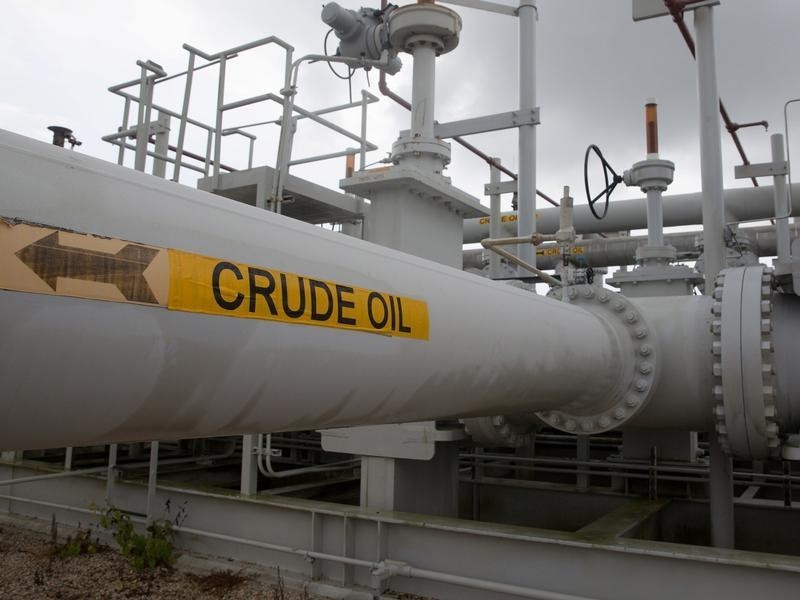Commodities
Energy & precious metals – weekly review and outlook


© Reuters.
Investing.com – Is the macro picture for oil and gold changing? The softer-than-expected for June sent both crude and the yellow metal rallying on Friday as the dollar tumbled its most in a day percentage-wise since February. All eyes are now on the coming week’s reading on , which, if tame, could unleash more risk appetite.
Yet, there’s no sign that the Federal Reserve – which is the point of all this fuss – is having a rethink about at least twice more before the year is out.
The Fed, as we know, has brought rates to a peak of 5.5% from the 0.25% they stood at prior to the pandemic. While the central bank paused its rate hike cycle last month, there’s every chance it could resume that when it meets on July 26 for its next rates review.
To be sure, Chicago Fed chief Austan Goolsbee made no bones on what he thought about the jobs report, telling CNBC soon after it was out:
“I still want to see the inflation data. I haven’t seen anything that says one or two more rate hikes this year is wrong. We can have one to two more rate hikes this year.”
U.S. employers added 209,000 jobs in June, according to Labor Department data on Friday that came in below economists’ estimates for the first time in 16 months, signaling progress in the Fed’s bid to fight inflation with higher interest rates.
There was an important caveat though: Wages expanded by 0.4% from a 0.3% growth in May even as the remained unchanged at 3.6%.
The Consumer Price Index – whose release next Wednesday everyone is waiting for – grew at 4% per annum in May. The Fed’s favorite price indicator, the , or PCE, Index, meanwhile, expanded by 3.8%.
Both are twice higher than the Fed’s target. But if Wall Street’s economists are right, CPI could get as low as 3.1% for June.
“I am still undecided on what the Fed should do on rates in July,” Goolsbee said. “I haven’t seen anything that says 1 or 2 more rate hikes this year is wrong.”
The crude rally suggests that oil bulls think they may finally be getting a break on rate hike concerns. Gold, meanwhile, kept its $1,900 handle on signs that the U.S. labor market may finally be cooling.
Craig Erlam, analyst at online trading platform OANDA, seems to think as much, asking in his market commentary Friday, “Could we finally be about to see a breakout in oil prices after two months of consolidation?”, before noting that the run-up from the range lows “has been quite strong and backed by momentum.”
But Simon Moore, chief investment adviser at FutureAdvisor, noted in a Forbes commentary something many have missed: Both headline and core (non-energy) inflation has been lowered over the past year by falling energy costs. If oil prices keep nudging higher after this, one can imagine what that might do to inflation.
Oil: Market Settlements and Activity
U.S. crude hit a one-month high on Friday with New York-based , or West Texas Intermediate, reaching nearly $74 the first time since June 5 with an intraday high of $73.91 per barrel. The U.S. crude benchmark did a final trade of $73.71, after settling the session officially at $73.86, up $2.06, or 2.9%, on the day. For the week, WTI was up 4.6%, adding to the previous week’s 2.1% gain.
London-based settled up $1.95, or 2.6%, at $78.47 after a one-month high of $78.53. Brent rose 4.8% on the week after the prior week’s 1.4% rise.
Oil: Price Outlook
Going into the week ahead, WTI is expected to retest breakout areas, said Sunil Kumar Dixit, chief technical strategist at SKCharting.com.
But consolidation could still limit U.S. crude to the 50-day EMA, or Exponential Moving Average, of $71.70, which – if broken – might see bears regain control in pushing for a correction back towards $70.30, or even $68.
The greater likelihood though was momentum accumulation from support areas that would “very likely resume the uptrend”, Dixit said, adding:
“The target is to retest the swing high of $73.90, followed by a strong breakout above resistance for the next leg higher, which is the 200-day SMA of $77.30 followed by the 50-week EMA of $78.60.”
Gold: Market Settlements and Activity
Gold neared the mid-$1,900 point on Friday while the spot price of bullion was not too far away from that after a softer-than-expected U.S. jobs report for June suggested some tempering in Fed’s hawkishness when the central bank’s policy-makers sit for their next rate review in three weeks.
The on New York’s Comex did a final trade of $1,930.50, after officially settling the session at $1,932.50, up $17.35, or 0.9%, on the day. For the week, the benchmark gold futures contract was virtually flat, gaining just over $3. Friday’s high of $1,940.90 for August gold compared with its three-month bottom last week at $1,900.60.
The , which reflects physical trades in bullion and is more closely followed than futures by some traders, settled at $1,925.30. The intraday high of $1,926.90 contrasted with last week’s three-month low of $1,893.01.
“Gold came under pressure … but managed to hold above $1,900 and even recoup some of its losses” after the Labor Department reported that U.S. employers added 209,000 nonfarm payrolls in June, noted Craig Erlam at OANDA.
Gold: Price Outlook
Gold’s acceptance above the Daily Middle Bollinger Band of $1,931, followed by the 5-week EMA of $1934 will ease the path for a further upside towards the 50-day EMA of $1,945, said SKCharting’s Dixit.
That would coincide with the 50% Fibonacci level of retracement measured from the $1,804 low to the $2081 high, he added.
“The next cluster of resistance is seen at the 100-day SMA of $1,948 and the Weekly Middle Bollinger Band of $1,952,” Dixit said.
“Failure to make a decisive breakout above this zone will keep chances of bearish correction valid, eventually leading to a retest of the $1915-$1910 support area, which is an acceleration point for deeper correction into the 50-week EMA of $1,885 as the initial downside target.”
A daily/weekly close above the $1,945-$1,952 will turn gold bullish for the short term, with $1,975 as the immediate upside target, with short-term resistance in the $1,935-$1,945-$1,952 range, said Dixit.
A daily/weekly close below the $1,910-$1,900 range will extend gold’s correction, pushing it towards the $1,885-$1,866-$1,845, he added.
Natural gas: Market Settlements and Activity
Natural gas’s run to $3 pricing may have to wait a little more as U.S. weather models showed an easing of the heatwave of the past three weeks as the near-term temperature outlook suggests mixed trends.
, the most-active natural gas contract the New York Mercantile Exchange’s Henry Hub fell 2.7 cents, or 1%, to settle at $2.609 per mmBtu, or million metric British thermal units. For the week, the benchmark gas futures contract lost 8%. It was the first weekly loss for gas in five weeks.
Friday’s low of $2.543 for August gas also marked its first return to mid-$2 levels in two weeks. Last Monday, August gas peaked at $2.936, the loftiest level for a front-month gas contract on the Henry Hub since March.
The latest tumble in gas came after the weekly published by the U.S. Energy Information Administration, or EIA, showed a higher-than-forecast build of 72 billion cubic feet, or bcf.
Industry analysts tracked by Investing.com had expected U.S. utilities to add just around 64 bcf to storage last week – little changed from the 63-bcf injection during the same week a year ago and the five-year (2018-2022) average increase of 64 bcf. In the prior week, utilities added 76 bcf to storage.
Gas prices also slumped as the heatwave that had seized Texas and the southern U.S. region over the past four weeks dissipated, curtailing air-conditioning and power burn demand. Natural gas experienced its biggest monthly rally in nearly a year in June, gaining 24%, as the cooling needs of Texans and other Southerners in the U.S. went through the roof.
While New York and other Eastern U.S. states experienced their first dalliance with 90 degree Fahrenheit temperatures this week and the Californian and West Coast summer ramped up as well, the transition wasn’t intensive or smooth enough to pick up the demand slack from the retreat in southern heat, said those tracking the weather models.
“The -2.9 bcf/d drop in power burn today was driven by multiple regions, suggesting a widespread drop in demand,” analysts at Houston-based energy markets advisory Gelber & Associates said in a note to their clients in natural gas. “This eclipsed other changes in fundamentals, including a 0.9 Bcf/d increase in ResComm and 0.45 bcf/d increase in production.”
Rescomm refers to the three major consuming segments in the natural gas market made up of power generation, industrial and residential plus commercial demand.
Natural gas: Price Outlook
In what appeared to be a natural correction resulting from a retest of breakout zones, natural gas could consolidate further, said SKCharting’s Dixit.
Daily Stochastics at 34/43 favors more drops while Daily RSI, or Relative Strength Index, at 51 is above neutrality, meaning further downside may be limited to the 100-day SMA of $2.38, Dixit said
“In the event of momentum accumulation from the aforementioned support zone, the uptrend is very likely to resume in retesting a swing high of $2.93, followed by targeting the 100-month SMA of $3.25. Strong breakout above this zone will be required for reaching the next leg higher, that is a confluence of the 200-week SMA of $3.75 and the 50-week EMA of $3.77.”
Disclaimer: Barani Krishnan does not hold positions in the commodities and securities he writes about.
Commodities
Oil prices rise; U.S. crude inventories plunge, Russia-Ukraine truce eyed
Commodities
India’s Reliance to stop buying Venezuelan oil over US tariffs, sources say
Commodities
Oil prices climb on Venezuela supply worries

 Forex3 years ago
Forex3 years agoForex Today: the dollar is gaining strength amid gloomy sentiment at the start of the Fed’s week

 Forex3 years ago
Forex3 years agoUnbiased review of Pocket Option broker

 Forex3 years ago
Forex3 years agoDollar to pound sterling exchange rate today: Pound plummeted to its lowest since 1985

 Forex3 years ago
Forex3 years agoHow is the Australian dollar doing today?

 Cryptocurrency3 years ago
Cryptocurrency3 years agoWhat happened in the crypto market – current events today

 World3 years ago
World3 years agoWhy are modern video games an art form?

 Commodities3 years ago
Commodities3 years agoCopper continues to fall in price on expectations of lower demand in China

 Economy3 years ago
Economy3 years agoCrude oil tankers double in price due to EU anti-Russian sanctions























